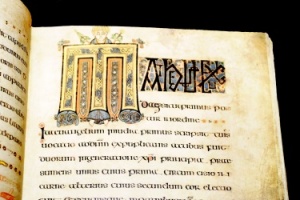The Old Irish Bee Laws – An Bechbretha:
 The Old Irish Bee Laws :An Bechbretha:
The Old Irish Bee Laws :An Bechbretha:
From the earliest times Ireland was noted for its abundance of honey.
In Ireland during the early medieval period beekeeping was so important that there was a complete list of laws dedicated to beekeeping. The bee laws, called the Bechbreatha (Bee-judgments) were part of a set of laws that governed the country called the Brehon Laws. Of all the laws relating to land and agriculture, the most attention was paid to role and significance of the bee in Irish culture at the time.
The management of bees was universally understood; and every comfortable householder kept hives in his garden. Wild bees, too, swarmed everywhere —much more plentifully than at present, on account of the extent of woodland. Before cane-sugar came into general use—sixteenth century—the bee industry was considered so important that a special section of the Brehon Laws is devoted to it.
The Brehon Law tract on “Bee-judgments,” of which the printed Irish text occupies over twenty pages dedicated to bees and beekeeping covering swarms, hives and honey production. The text enters into much detail concerning the rights of the various parties concerned, to swarms, hives, nests, and honey: of which a few examples are given here. If a man found a swarm in the faithche [faha], or green surrounding and belonging to a house: one-fourth of the produce to the end of a year was due to the finder, the remaining three -fourths to the owner of the house. If he found them in a tree growing in a faithche or green: one-half produce for a year to the finder: the rest to the owner. If they were found in land which was not a green: one-third to the finder and two-thirds to the owner of the land. If found in waste land not belonging to an individual, but the common property of the tribe, bees and honey belonged to the finder, except one-ninth to the chief of the tribe. As the bees owned by an individual gathered their honey from the surrounding district, the owners of the four adjacent farms were entitled to a certain small proportion of the honey: and after the third year each was entitled to a swarm. If bees belonging to one man swarmed on the land of another, the produce was divided in certain proportions between the two. The Irish have at least 6 different traditional terms for the varieties of naturally occurring bee swarms. The 7th century Bechbretha,an Old Irish law-tract on beekeeping, details these and many other old beekeeping practices. Special laws designed to protect bees and beekeepers were called the ‘bech bretha.
A mixture of milk and honey was sometimes drunk; a mixture of lard and honey was usual as a condiment. Honey was sometimes brought to table pure, and sometimes in the comb. Often at meals each person had placed before him on the table a little dish, sometimes of silver, filled with honey; and each morsel whether of meat, fish, or bread was dipped into it before being conveyed to the mouth.